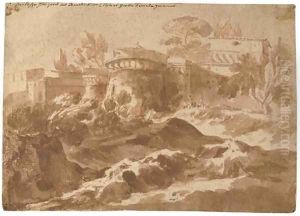Alessio De'Marchis Paintings
Alessio De'Marchis, born in 1609 and deceased in 1688, was an Italian painter whose work primarily spanned the Baroque period, a time characterized by dramatic use of color, light, and shadow to achieve a sense of movement and realism. Although not as widely recognized as some of his contemporaries, De'Marchis made notable contributions to the artistic movements of his time, particularly in the realms of landscape and still life painting.
Hailing from the region around Naples, De'Marchis was part of a cultural milieu that was deeply influenced by the naturalistic styles of Caravaggio and the dynamic compositions of Annibale Carracci. This influence is evident in his works, which often feature a keen observation of the natural world combined with a dramatic flair. His landscapes, in particular, are marked by a luminous quality, capturing the transient effects of light with a delicate precision that prefigures the later developments in landscape painting.
De'Marchis was also adept at still life, a genre that was gaining popularity during his lifetime. His still lifes are characterized by a meticulous attention to detail and a vibrant palette that brings the depicted objects to life. These works not only showcase his technical skill but also reflect the contemporary interest in botany and the natural sciences, themes that were increasingly prominent in the art of the seventeenth century.
Despite his talents, Alessio De'Marchis did not achieve the same level of fame as some of his peers. His work was, however, appreciated by those who were familiar with it, and he received commissions from both religious and secular patrons. After his death in 1688, De'Marchis's contributions to the Italian Baroque were somewhat overshadowed by the more dominant figures of the era, and he remained a relatively obscure figure in art history.
In recent years, there has been a renewed interest in the works of De'Marchis and other lesser-known artists of the Baroque period. This resurgence of interest is part of a broader reevaluation of the period that seeks to understand the full diversity of artistic expression during this time. Today, Alessio De'Marchis is recognized for his unique contributions to the development of landscape and still life painting, and his works can be found in several Italian museums, where they continue to be studied and admired for their beauty and historical significance.
